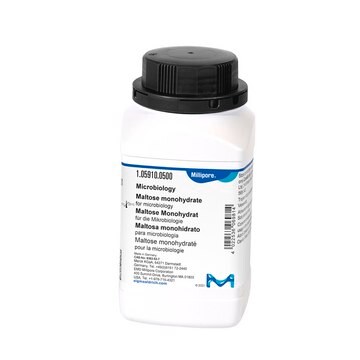77653
Maltose Disks
suitable for microbiology, Sterile filter paper discs impregnated with maltose
Sinónimos:
Carbohydrate discs
About This Item
Productos recomendados
Quality Level
sterility
sterile
product line
BioChemika
form
disc
shelf life
limited shelf life, expiry date on the label
packaging
pkg of 10 × 25 discs
technique(s)
microbe id | utilization test: suitable
application(s)
clinical testing
environmental
food and beverages
pharmaceutical
microbiology
storage temp.
2-8°C
suitability
Citrobacter spp.
Enterobacter spp.
Escherichia coli
Klebsiella spp.
Neisseria spp.
Proteus spp.
Salmonella spp.
Serratia spp.
Shigella spp.
Streptococcus spp.
bacteria
General description
Application
Storage Class
11 - Combustible Solids
wgk_germany
WGK 3
flash_point_f
Not applicable
flash_point_c
Not applicable
ppe
Eyeshields, Gloves, type N95 (US)
Elija entre una de las versiones más recientes:
¿Ya tiene este producto?
Encuentre la documentación para los productos que ha comprado recientemente en la Biblioteca de documentos.
Artículos
Sigma-Aldrich.com presents an article concerning Differentiation of Escherichia coli from coliforms.
Salmonella contamination is the second leading cause of food-borne illness worldwide. Controlling outbreaks of Salmonella is an important task for food regulators, restaurants and the food industry in general. The Salmonella family includes over 2,300 serotypes of bacteria, but two types, Salmonella enteritidis and Salmonella typhimurium, are responsible for about half of all human infections. Most outbreaks of Salmonella are traced back to dairy, poultry and meat products, but Salmonella can grow on nearly any food. Chicken, eggs and their derivative products are particularly high risk.
Nuestro equipo de científicos tiene experiencia en todas las áreas de investigación: Ciencias de la vida, Ciencia de los materiales, Síntesis química, Cromatografía, Analítica y muchas otras.
Póngase en contacto con el Servicio técnico


